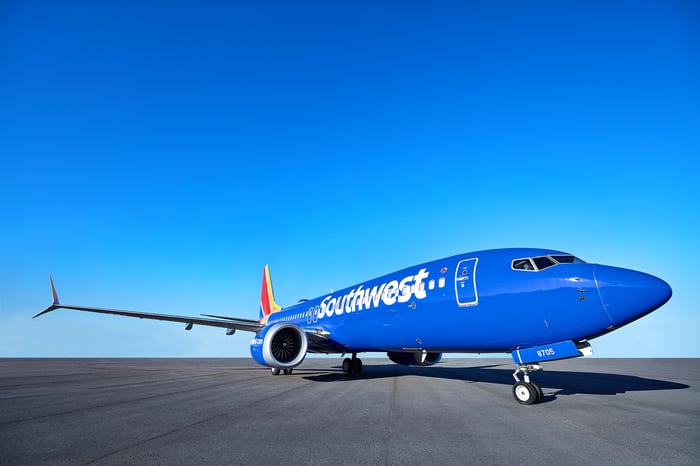The COVID-19 pandemic wreaked havoc on U.S. airlines last year, and it will take a long time for the air travel industry to heal completely. However, investors just got a sign that the recovery is beginning in earnest. On Thursday, Southwest Airlines (LUV 0.73%) reported a first-quarter profit under generally accepted accounting principles (GAAP). That makes it the first major airline to earn a quarterly profit since early 2020.
Southwest Airlines generated $2.05 billion of revenue last quarter-- down 51.5% year over year and down 60.1% compared to the first quarter of 2019.
The quarter started slowly, with revenue 64% to 65% lower than 2019 levels in January and February. Booking trends began to improve rapidly in mid-February, though. As a result, revenue for March came in just 53.5% below the same period of 2019 -- a substantial sequential improvement.
This inflection in Southwest's revenue trend enabled the airline to book a GAAP profit of $116 million ($0.19 per share) for Q1. It's fitting that Southwest was the first U.S. airline to return to GAAP profitability. The low-fare airline recorded 47 consecutive annual profits -- unprecedented in the airline industry -- before the pandemic finally ended the streak last year.

Image source: Southwest Airlines.
Special items drove the return to profitability
Returning to GAAP profitability was an important accomplishment, but Southwest Airlines did need some big government subsidies to get there. Most notably, it recorded a $1.2 billion pre-tax benefit last quarter from the second iteration of the federal government's payroll support program for airlines. It also booked a $116 million employee retention credit.
Additionally, Southwest took a $613 million special charge in 2020 related to the estimated cost of its voluntary extended leave program. It reversed part of that special charge last quarter after deciding to recall some employees to work sooner than it had previously expected to. This pre-tax special credit of $115 million also contributed to the airline's return to GAAP profitability.
Stripping out all of those special items, Southwest reported an adjusted net loss of $1 billion ($1.72 per share) for the first quarter. That still beat the average Wall Street estimate by $0.13 per share.
While it's important to acknowledge the impact of special credits like the payroll support grants on Southwest's Q1 profitability, other airlines also benefited from them but continued to lose money on a GAAP basis. Furthermore, the payroll support windfall wasn't exactly a one-time occurrence. Southwest Airlines expects to receive over $2 billion in additional payroll support funds -- roughly 70% of which will come in the form of grants -- before year's end.
The future looks bright
The pandemic isn't over yet, so there's some risk that the recent rebound in leisure travel demand won't last long. However, recent booking trends are very promising. Southwest Airlines currently projects that its April revenue will be down by 40% to 45% relative to April 2019, and down in May by 35% to 40% compared to May 2019.

Image source: Southwest Airlines.
Moreover, management is feeling very confident about summer demand. Advance bookings for June and July are near their normal pre-pandemic levels. As a result, Southwest plans to operate just 4% less capacity in June than it did in June 2019. That compares to capacity reductions of more than 40% as recently as February.
The ongoing demand ramp-up has Southwest Airlines poised to shrink its adjusted net loss significantly in the second quarter. Due to the additional payroll support it will receive, the airline will probably post another GAAP profit. And barring any further setbacks, resurgent demand should enable Southwest to become consistently profitable again on an adjusted basis (stripping out one-time credits like payroll support funds) in the second half of 2021.
While Southwest Airlines' business is on the road back to health, its share price has already recovered. In fact, its market cap has surged by 30% since the beginning of 2020 (i.e., before the pandemic). That leaves little upside for investors, notwithstanding Southwest's solid recovery trajectory.





